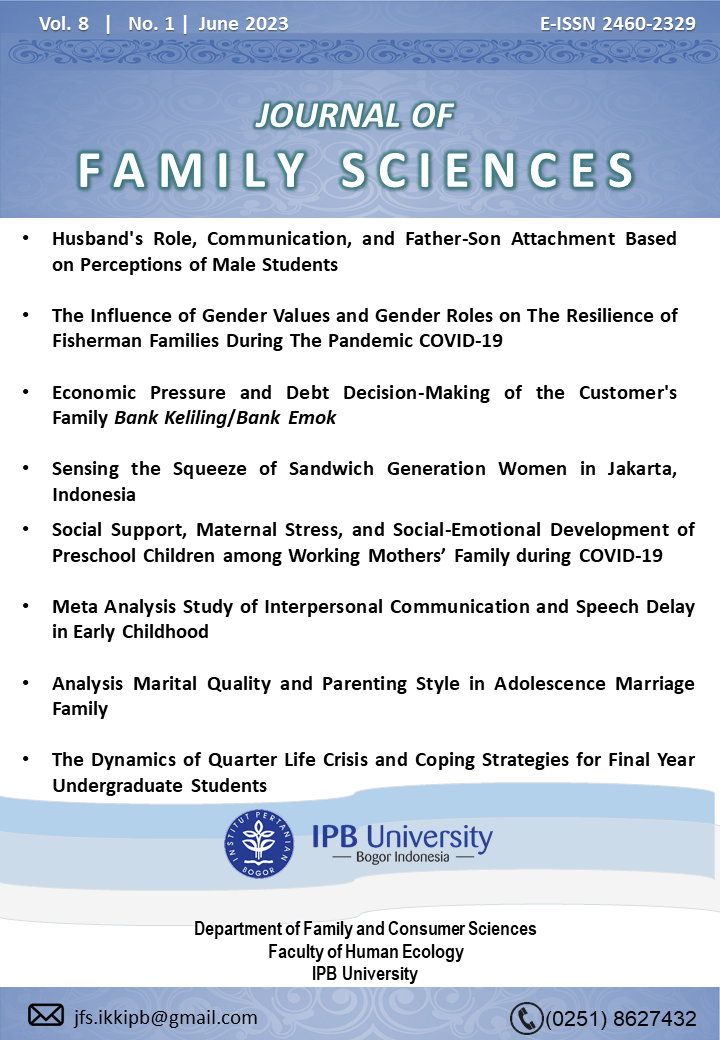Meta Analysis Study of Interpersonal Communication and Speech Delay in Early Childhood
Meta Analysis Study of Interpersonal Communication and Speech Delay in Early Childhood
Abstract
Speech delay in children is closely related to their interpersonal communication. Previous studies have found that 10-20 percent of young children experience speech delay which ultimately affects their interpersonal communication. The purpose of this study was to examine the effect size of the different test and the correlation of the results of the study which linked children's interpersonal communication and speech delay. This meta-analysis uses 14 research journals. There are 11 journals using the correlation method and 3 journals using the different test method. Data were analyzed using effect size correlation and effect size difference tests. The results showed that interpersonal communication has a large correlation size effect on speech delay with r = 0.504. The different test has a small effect size, g = 0.329. The results of the correlation effect size and the different test effect size are formed by external factors related to stimulation and family support, as well as a positive environment.
Downloads
References
American Psychiatric Association. (2013). Diagnostic and statistical manual of mental disorders, 5th ed. (DSM-5). Washington DC(US): American Psychiatric Association.
Bello, A., Onofrio, D., Remi, L., & Caselli, C. (2018). Research in developmental disabilities prediction and persistence of late talking: A study of Italian toddlers at 29 and 34 months. Research in Developmental Disabilities, 75, 40–48. https://doi.org/10.1016/j.ridd.2018.02.006
Bishop, D. V., Holt, G., Line, E., McDonald, D., McDonald, S., & Watt, H. (2012). Parental phonological memory contributes to prediction of outcome of late talkers from 20 months to 4 years: A longitudinal study of precursors of specific language impairment. Journal of Neurodevelopmental Disorders, 4(1), 3. http://dx.doi.org/ 10.1186/1866-1955-4-3.
Cable, A. L., & Domsch, C. (2011). Systematic review of the literature on the treatment of children with late language emergence. International Journal of Language and Communication Disorders, 46(2), 138–154. https://doi.org/10.3109/13682822.2010.487883
Campbell, T. F., Dollaghan, C. A., Rockette, H. E., Paradise, J. L., Feldman, H. M., Shriberg, L. D., Sabo, D. L., & Kurs-Lasky, M. (2003). Risk factors for speech delay of unknown origin in 3-year-old children. Child Development, 74(2). https://doi.org/10.1111/1467-8624.7402002
Collisson, B. A., Graham, S. A., Preston, J. L., Rose, M. S., McDonald, S., & Tough, S. (2016). Risk and protective factors for late talking: An epidemiologic investigation. Journal of Pediatrics, 172, 168-174.e1. https://doi.org/10.1016/j.jpeds.2016.02.020
Conti Ramsden, G., & Friel Patti, S. (1983). Mothers’ discourse adjustments to language-impaired and non-language-impaired children. Journal of Speech and Hearing Disorders, 48(4), 360–367. https://doi.org/10.1044/jshd.4804.360
Conti‐Ramsden, G., & Dykins, J. (1991). Mother‐child interactions with language‐ impaired children and their siblings. International Journal of Language & Communication Disorders, 26(3), 337–354. https://doi.org/10.3109/13682829109012019
Conway, L., Levickis, P., Smith, J., Mensah, F., Wake, M., & Reilly, S. (2018). Maternal communicative behaviours and interaction quality as predictors of language development: findings from a community-based study of slow-to- talk toddlers. International Journal of L. December.
Dahm, P. S. (1989). Communication and Socialization Skills of Three Year Olds with a History of Language Delay. [Theses]. Portland State University. Department of Speech Communication
DeVito, J. (2015). The Interpersonal Communication Course. Basic Communication Course Annual, 3(1), 1–20.
Down, K., Levickis, P., Hudson, S., Nicholls, R., & Wake, M. (2014). Measuring maternal responsiveness in a community-based sample of slow-to-talk toddlers: a cross-sectional study. Child Care Health Dev (2), 329–334. https://doi.org/10.1111/cch.12174
Foster-cohen, S. H., & Bysterveldt, A. K. Van. (2016). Assessing the communication development of children with language delay through parent multi-questionnaire reporting Assessing the communication development of children with language delay through parent multi-questionnaire reporting. Speech, Language and Hearing, 5728(June). https://doi.org/10.1080/2050571X.2015.1108067
Girolametto, L., Bonifacio, S., Visini, C., Weitzman, E., Zocconi, E., & Pearce, P. S. (2002). Mother-child interactions in Canada and Italy: Linguistic responsiveness to late-talking toddlers. International Journal of Language and Communication Disorders, 37(2), 153–171. https://doi.org/10.1080/13682820110116794
Gjersoe, N. L., & Havard, C. (2017). Developmental psychology. Forensic Psychiatry: Fundamentals and Clinical Practice, 51–61. https://doi.org/10.1201/978131538079
Hatfield, B. E., Burchinal, M. R., Pianta, R. C., & Sideris, J. (2016). Early Childhood Research Quarterly Thresholds in the association between quality of teacher – child interactions and preschool children’ s school readiness skills. Early Childhood Research Quarterly, 36, 561–571. https://doi.org/10.1016/j.ecresq.2015.09.005
Hawa, V. V., & Spanoudis, G. (2014). Toddlers with delayed expressive language: An overview of the characteristics, risk factors and language outcomes. Research in Developmental Disabilities, 35(2), 400–407. https://doi.org/10.1016/j.ridd.2013.10.027
Hudson, S., Levickis, P., Down, K., Nicholls, R., & Wake, M. (2015). Maternal responsiveness predicts child language at ages 3 and 4 in a community- based sample of slow-to-talk toddlers. International Journal of Language and Communication Disorders, 50(1), 136–142. https://doi.org/10.1111/1460-6984.12129
Hurlock, Elizabeth, B. (1980). Developmental Psychology: A Life-Span Approach 5th Edition. AS: McGraw-Hill Inc. Terj. Istiwidayanti dan Soedjarwo, Psikologi Perkembangan: Suatu Pendekatan Sepanjang Rentang Kehidupan Edisi Kelima. Jakarta(ID): Penerbit Erlangga, 1980.
Hurlock. (2013). Perkembangan Anak, Jilid 1. Jakarta(ID): Erlangga.
Indah, R. N. (2017). Gangguan berbahasa: Kajian Pengantar. UIN-Maliki Press, Malang. ISBN 978-602-958-401-1 UNSPECIFIED: UNSPECIFIED.
Jamaris, M. (2006). Perkembangan dan Pengembangan Anak Usia Taman Kanak-Kanak. Jakarta(ID): Grasindo. Jakarta.
King, W. R. (2005). Understanding the role and methods of meta- analysis in is research meta-analysis in is research. Communications of the Association for Information Systems, 16(October). https://doi.org/10.17705/1CAIS.01632
Korpilahti, P., Kaljonen, A., & Jansson-Verkasalo, E. (2016). Identification of biological and environmental risk factors for language delay: The Let’s Talk STEPS study. Infant Behavior and Development, 42, 27–35. https://doi.org/10.1016/j.infbeh.2015.08.008
Levickis, P., Reilly, S., Girolametto, L., Ukoumunne, O. C., & Wake, M. (2014). Maternal Behaviors Promoting Language Acquisition in Slow-to-Talk Toddlers. of Developmental & Behavioral Pediatrics, 35(4), 274–281. https://doi.org/10.1097/dbp.0000000000000056
Matthew, J., Joanne, E., Patrick, M., Page, M. J., Mckenzie, J. E., Bossuyt, P. M., Boutron, I., Hoffmann, T. C., Mulrow, C. D., Shamseer, L., Tetzlaff, J. M., Akl, E. A., Brennan, S. E., Chou, R., Glanville, J., Grimshaw, J. M., Mayo-wilson, E., Mcdonald, S., Mcguinness, L. A., … Moher, D. (2021). Article: The PRISMA 2020 statement: An updated guideline for reporting systematic reviews.
Mehta B, Chawla V. K, Parakh, M., Parakh, P., Bhandari, B., & Gurjar, A. S. (2015). EEG abnormalities in children with speech and language impairment. J Clin Diagn Res, 9(7), CC04-CC07.
Morgan, L., Delehanty, A., Cleary, J., Schatschneider, C., & Wetherby, A. M. (2020). Early Childhood Research Quarterly Measures of early social communication and vocabulary production to predict language outcomes at two and three years in late- talking toddlers. Early Childhood Research Quarterly, 51, 366–378. https://doi.org/10.1016/j.ecresq.2019.12.005
Nair, M. K. C., Mini, A. O., Leena, M. L., George, B., Harikumaran Nair, G. S., Bhaskaran, D., & Russell, P. S. S. (2014). CDC Kerala 7: effect of early language intervention among children 0-3y with speech and language delay. Indian Journal of Pediatrics, 81(2), 102–109, 2014. https://doi.org/10.1007/s12098-014-1555-8
Neslon, H. D., Nygren, P., Wlker, M., & Rita. P. (2006). Screening for speech and language delay in preschool children: systematic evidence review for the US preventive services task force. Pediatrics, 117, 298–319, 2006. https://doi.org/10.1542/peds.2005-1467
Nilsen, D. L. F., & Brown, R. (1974). A First Language: The Early Stages. The Modern Language Journal, 58(5/6), 268. https://doi.org/10.2307/325028
Page, M. J., Mckenzie, J. E., Bossuyt, P. M., Boutron, I., Hoffmann, C., Mulrow, C. D., Shamseer, L., Tetzlaff, J. M., Akl, E. A., Brennan, S. E., Chou, R., Glanville, J., Grimshaw, J. M., Hróbjartsson, A., Lalu, M. M., Li, T., Loder, E. W., Mayo-wilson, E., Mcdonald, S., … Moher, D. (2021). The PRISMA 2020 statement: an updated guideline for reporting systematic reviews Systematic reviews and Meta-Analyses. https://doi.org/10.1136/bmj.n71
Paul, R., Looney, R. R., & Dahm, P. S. (1991). Communication and socialization skills at ages 2 and 3 in "late-talking" young children. J Speech Hear Res, 34(4), 858-65. doi: 10.1044/jshr.3404.858.
Pearson, J. C., Nelson, P. E., Titsworth, S., & Harter, L. (2011). Human Communication Fourth Edition. New York(US): McGraw-Hill Education
Retnawati, H., Apino, E., Kartianom, Djidu, H., & Anazifa, R. D. (2018). Pengantar Analisis Meta (Edisi 1). Yogyakarta(ID): Parama Publishing
Santrock, J. W. (2010). Life Span Development (Pekembangan Masa-Hidup). Jakarta(ID): Erlangga
Suparmiati, A., Ismail, D., & Sitaresmi, M. N. (2013). Hubungan ibu bekerja dengan keterlambatan bicara pada anak. Sari Pediatri, 14(5), 3–6. https://dx.doi.org/10.14238/sp14.5.2013.288-91
van Tiel, J. M. (2009). Permasalahan deteksi dan penanganan anak cerdas istimewa dengan gangguan perkembangan bicara dan bahasa ekspresif (gifted visual- spatial learner). Psikobuana, 1(2), 128–146.
Vibbert, M., & Bornstein, M. H. (1989). Specific associations between domains of mother-child interaction and toddler referential language and pretense play. Infant Behavior and Development, 12(2), 163–184. https://doi.org/10.1016/0163 6383(89)90004-0
Wake, M., Tobin, S., & Girolametto, L. (2011). Outcomes of population based language promotion for slow to talk toddlers at ages 2 and 3 years: Let ’ s Learn Language cluster randomised controlled trial. BMJ, 1–10. https://doi.org/10.1136/bmj.d4741
Wilson, P., Mcquaige, F., Thompson, L., & Mcconnachie, A. (2013). Language delay is not predictable from available risk factors. The Scientific World Journal, Volume 2013, Article ID 947018, 8 pages. http://dx.doi.org/10.1155/2013/947018
Wood, J. T. (2008). Communication In Our Lives Fifth Edition. Boston(US): Cengage Learning Academic Resource Center
Wren, Y., Miller, L., Peter, J. T., Emond, A., & Ralston, S. (2016). Prevalence and predictors of persistent speech sound disorder at eight years old: Findings from a population cohort study. J Speech Lang Hear Res, 59, 647-73. https://doi.org/10.1044/2015_jslhr-s-14-0282
Wulbert, M., Inglis, S., Kriegsmann, E., Mills, B., & Ritt, V. De. (1975). Language delay and associated mother-child interactions. Developmental Psychology, 11(1), 61–70. https://psycnet.apa.org/doi/10.1037/h0076125
Xuan, L., & Dollaghan, C. (2013). Language-specific noun bias: Evidence from bilingual children. Journal of Child Language, 40(5), 1057–1075. https://doi.org/10.1017/S0305000912000529
Yew, S. G. K., & O’Kearney, R. (2013). Emotional and behavioral outcomes later in childhood and adolescence for children with specific language impairments: Meta-analyses of controlled prospective studies. The Journal of Child Psychology and Psychiatry, 54(5), 516–524. https://doi.org/10.1111/jcpp.12009
Zambrana, I. M., Pons, F., Eadie, P., & Ystrom, E. (2014). Trajectories of language delay from age 3 to 5: Persistence, recovery and late onset. International Journal of Language and Communication Disorders, 49(3), 304–316. https://doi.org/10.1111/1460-6984.12073
Zhao, B., Liu, Y., Liu, J., & Liu, Y. (2022). Early family intervention in children with language delay: the effect of language level and communication ability. Evid Based Complement Alternat Med, Article ID 3549912, 6 pages. https://doi.org/10.1155/2022/3549912
Authors who publish with this journal agree to the following terms:
- Authors retain copyright and grant the journal right of first publication with the work simultaneously licensed under

This work is licensed under a Creative Commons Attribution 4.0 International License. that allows others to share the work with an acknowledgement of the work's authorship and initial publication in this journal. - Authors are able to enter into separate, additional contractual arrangements for the non-exclusive distribution of the journal's published version of the work (e.g., post it to an institutional repository or publish it in a book), with an acknowledgement of its initial publication in this journal.
- Authors are permitted and encouraged to post their work online (e.g., in institutional repositories or on their website) prior to and during the submission process, as it can lead to productive exchanges, as well as earlier and greater citation of published work (See The Effect of Open Access).



_001.png)



